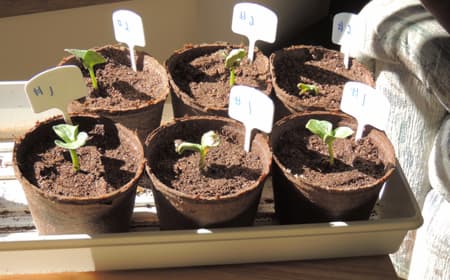Damping Off Plant Disease

Gardeners Dread Damping Off Disease
Somewhere lurking in the air in your house, is the fungus spores of damping off disease. For those of us who start plants indoors, it is the most dreaded indoor plant disease.
Damping Off Disease is a very common plant disease problem. We fear it because it is fatal to our young seedlings and equally harmful to our soaring spring spirits. To lose seedlings so early in the new gardening year, is just heartbreaking, especially if it is a special seed. Subsequently, it leads to replanting and gets our young gardening season off to a late start.
If you grow indoor transplants early in the spring, you likely have experienced it at some point. Most often, it is the new gardener that experiences damping off disease. It can happen to the most experienced gardener. We usually think of Damping Off Disease as an indoor plant problem. But, it also occurs outdoors, too. We are less likely to recognize it outdoors, as the loss of plants in the spring is often attributed to many other things that threaten our new seedlings.
Now for the good news… Damping Off Disease as a threat to your seedlings can be minimized, if not avoided altogether. We have lots of tips and ideas to help fight off this gardening enemy.
Identification of Damping Off Disease
Identifying this plant disease is easy. Here is how to identify it:
Previously healthy seedlings fall over. They do so, right at the soil level. You might not see the fungus at first. As the disease progresses, this white cottony fungus is clearly visible on top of the soil. As days, go by it, quickly worsens.
Causes of Damping Off Disease
Damping Off Disease thrives in cool or cold temperatures, dark or cloudy conditions, wet or damp soils. It is an airborne plant disease, and can spread very quickly from one seed tray to another.
The fungal spores take root in and on your soil, and quickly spreads across the seed tray, jumping to other trays with ease. It is fatal to young seedlings, nipping them off at the soil level.
How to Avoid Damping Off Disease
Controlling this disease is a matter of removing the environment that this disease thrives in. Here are the basic dos and don’ts:
Do:
Buy sterilized seed starting soil.
Use clean, sterilized containers.
Provide plenty of air circulation.
Tip: Use a small fan and direct a very gentle breeze across the plants. The important word here is “gentle”, as seedlings are delicate.
Thin seedlings to increase air circulation.
Provide as much sunlight as possible.
Let the surface of the soil dry out between watering. Watering from the bottom is much preferred.
Stir the top of the soil around the seedlings.
Put plants in a sunny location. It helps to keep the surface soil dry.
Do Not:
Seedling trays should not be left in the basement. Basements are perfect breeding grounds for molds and fungus.
Don’t overwater plants.
Avoid the use of fertilizer on your new seedlings.
Don’t use tray covers. While it is a popular practice to use them, they increase the humidity level and encourages disease growth.
Did you know? Nitrogen in your fertilizer can promote rapid growth of the disease.
Other Tips and Suggestions
It is believed that soaking seeds in a small amount of water and a clove of crushed garlic will prevent the disease.
Some people suggest misting the plant with Chamomile tea as a preventative.
Some people suggest fireplace ash on the top of the soil.
Cinnamon also acts as a fungicide.
Sphagnum moss spread thinly on the surface of the soil.
Disease Treatment
As with other plants diseases, prevention is the best means of treatment. If Damping Off Disease does take hold in your seed trays, act immediately. Remove diseased sections to minimize the spread. If it has affected a significant number of plants, replant in new soil and clean containers. Do not reuse the soil. Either use new containers or sterilize the ones you were using. We recommend new containers.
Additional Resources
Please support our site. Shop for:
- rmmatthews100@hotmail.com
- 585-721-6528
- Rochester, NY
©1999-2024 GardenersNet.Com, All Rights Reserved

